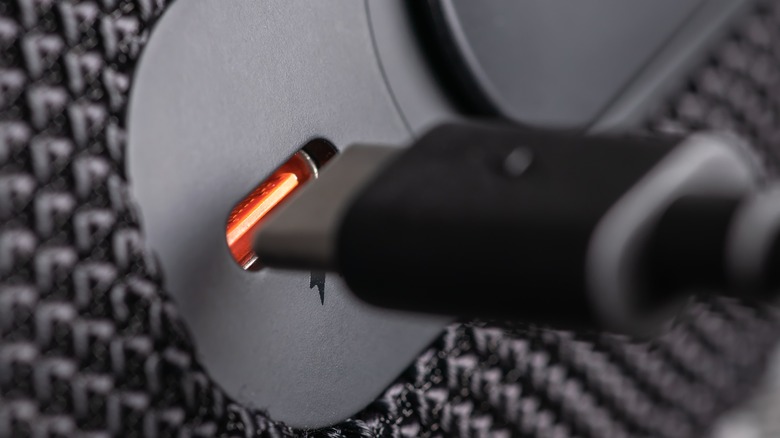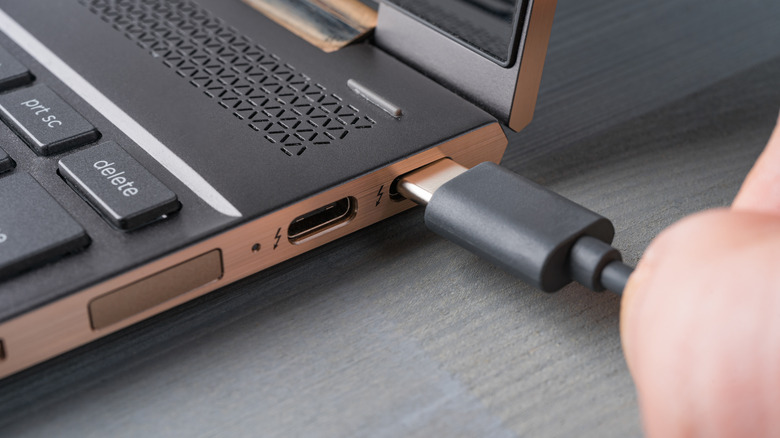What's The Difference Between USB-C & Thunderbolt Monitors?
Plenty of people require high-quality monitors for their personal computers, either for gaming, video editing, or just the desire to have a nice, big display. The question becomes how one is able to get that high-quality picture on their display. Having a 4K monitor is great, but if the connector from the computer to the monitor isn't the best, then you aren't getting the most use out of that 4K resolution. Those who frequently use high-resolution monitors typically find themselves connecting to their monitor through an HDMI or USB-C to DisplayPort connection, as these provide the proper bandwidth to see everything at their maximum quality.
USB-C posts have become quite popular for plugging devices into your computer. Depending on what else you have connected to your computer — be it a mouse, keyboard, or external hard drives — you may find yourself drowning in cables and out of suitable ports to plug in your power cables. USB-C cords have been a great benefit to this because they are bidirectional, so they are able to send a signal to your monitor while simultaneously sending power back (on many models) to your computer or laptop, freeing up an outlet space on your wall.
In recent years, another port type has become quite popular for the same purposes: Thunderbolt. At first glance, it looks identical to a USB-C, but their capabilities are quite different. Some companies have started coming out with external monitors that utilize a Thunderbolt connection, and this breakdown will help you see if it is right for you to make the switch.
Double the data
A USB-C connector, which stands for Universal Serial Bus Type-C, isn't actually the physical twin of a Thunderbolt connector, but the two are compatable. Both USB-C and Thunderbolt cords operate bidirectionally, meaning that a single cord could send the data from your computer to your monitor while sending back power to your computer from your monitor.
The main difference between the two is the data transfer speeds that you are able to get from them. With a USB-C connection, you are looking at a transfer rate of up to 20 GB of data per second, while a Thunderbolt connection doubles that to 40 GB per second. Not only that, but a Thunderbolt connection can also support a refresh rate of up to 240 Hz, making it an ideal fit for gamers.
Thunderbolt connections also make having a daisy chain with a second monitor much easier by simply adding one more cord connecting the two monitors. Because of the increased data rate, this configuration allows 4K material to be displayed with a 60 Hz refresh rate for each. A 20 GB USB-C transfer rate simply won't be enough to handle that kind of data.
Because USB-C and Thunderbolt look identical, you need to make sure that your computer actually has Thunderbolt ports and not just USB-C ones, which are designated with the Thunderbolt icon next to the port. Plugging a Thunderbolt connector into a USB-C port is only going to get you USB-C transfer speeds, so it's something to keep in mind.
A difference in price
Thunderbolt connections are a newer, more powerful technology than USB-C. Consequently, finding monitors that have Thunderbolt ports is going to prove a little challenging. Not only that, but these things are going to cost you quite a lot more than your average monitor. For example, take the 32" UHD UltraFine Monitor from LG. This is a very good 4K monitor that supports HDR10 with a 60Hz refresh rate for a respectable $299.99. This monitor uses a DisplayPort connection, which you are able to plug into your computer with either a USB-C to DisplayPort cable or just a standard DisplayPort cable if your computer supports that.
LG makes a similar monitor with a Thunderbolt connection. It's the same size, same resolution, and same refresh rate. However, this monitor goes for a whopping $1,299.99, a full grand more than the standard monitor. For a lot of people, that is just going to be way out of their price range, particularly if they need a second monitor as well.
Where you will find a more reasonably priced Thunderbolt monitor if you are looking for portable monitors for travel, such as the UPerfect UBegin B5 portable monitor going for $149.99, but that will just get you a 1080p display that doesn't maximize the Thunderbolt's capabilities. Thunderbolt connections may double the data speeds of USB-C connections, but it's up to you if you think the massive price increase is worth it.


